Alcon Research PUREPT1 PurePoint User Manual NGL Book 1 indb
Alcon Research Ltd. PurePoint NGL Book 1 indb
Contents
- 1. User Manual part 1 of 5
- 2. User Manual part 2 of 5
- 3. User Manual part 3 of 5
- 4. User Manual part 4 of 5
- 5. User Manual part 5 of 5
User Manual part 2 of 5
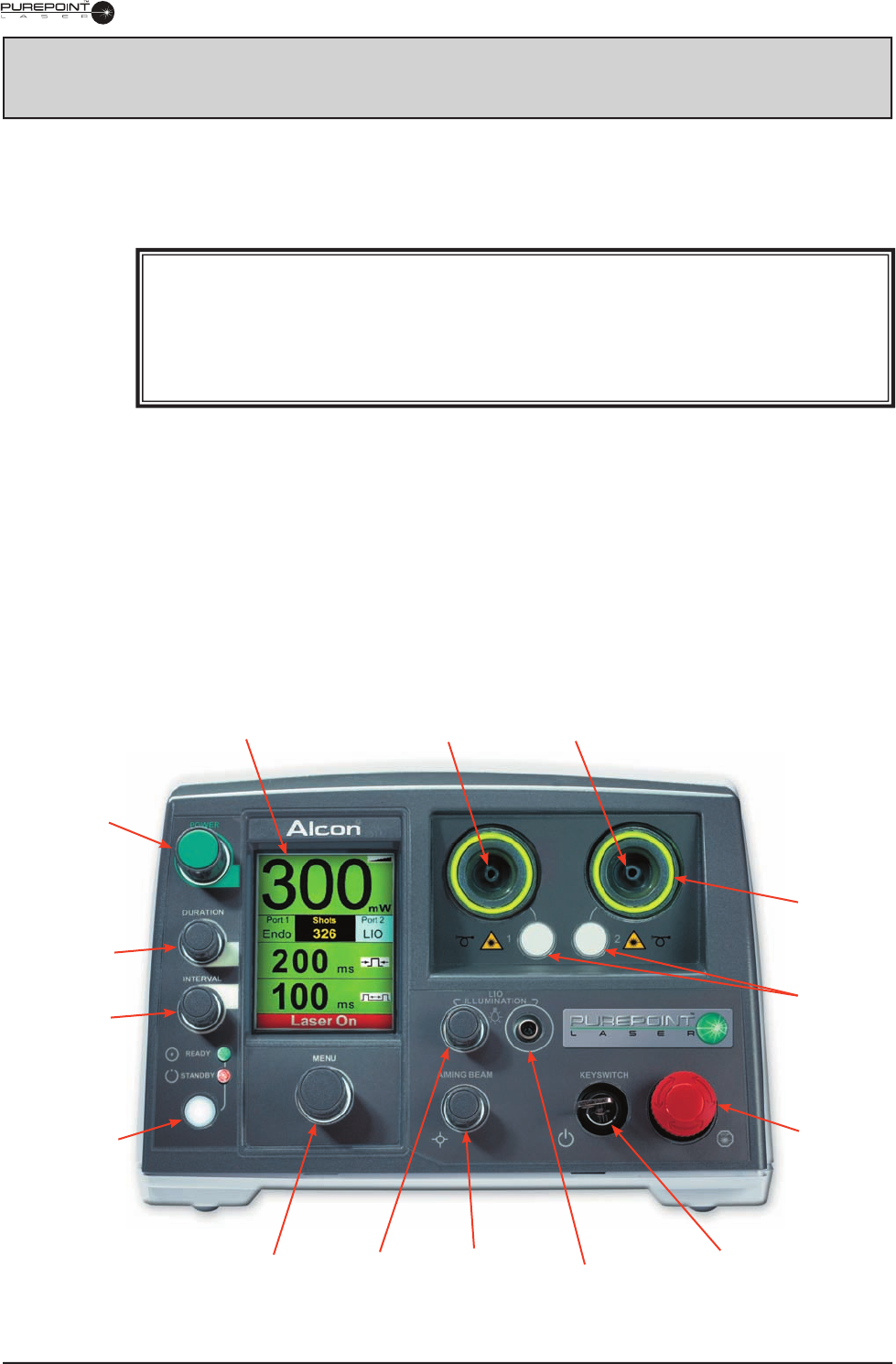
8065751131 2.1
SECTION TWO
DESCRIPTION
Figure 2-1 The PurePoint Laser Front Panel
INTRODUCTION
This section contains descriptions of the front panel, rear panel, and screens that are
displayed on the PurePoint Laser.
WARNINGS!
Use of controls, making adjustments, or performance of procedures other than
specified in this manual may result in hazardous laser radiation exposure.
Possible explosion hazard if used in the presence of flammable anesthetics or
other gas mixtures.
FRONT PANEL DESCRIPTION
The front panel, shown in fi gure 2-1, allows the operator to control, change settings,
and monitor the PurePoint Laser. Changes to the current system setup are confi rmed
by a system tone or voice confi rmation. For example: if the port selection or power
is changed, the system will emit a tone. The liquid crystal display (LCD) shows laser
parameters, operational prompts, and operator messages.
LCD Screen
Laser Port 1
Laser Port 2
Port
Illumination
Ring
Port
Selection
Buttons
Emergency
Switch
Key Switch
LIO Illuminator
Power Port
Aiming Beam
Intensity Knob
LIO Illuminator
LIO Illuminator
Power Knob
Menu Knob
Standby/Ready
Mode Button
Interval
Time Knob
Pulse
Duration
Knob
Power Knob

2.2
8065751131
LCD Screen
The LCD screen is the communication interface between
the surgeon and the system. It provides the surgeon with
system status and parameters by displaying text and icons
relevant to the current operating state. The background color
of this screen is gray when the system is in the Standby
state and green when is in the Ready state. When the laser is
fi red, "Laser On" is display in a red box at the bottom of the
screen.
Figure 2-2 shows a typical screen that may be displayed on
the LCD. Each screen displayed by the system is described
in detail later in this section. System messages (advisories,
errors, and warnings) are listed in the Troubleshooting
section of this manual.
Laser Ports 1 and 2
Dual SMA connectors are provided on the front panel to connect the
PurePoint™
Laser to the desired delivery system; i.e., Slit Lamp adaptation, Laser Indirect
Ophthalmoscope (LIO), or Endoprobe/Aspirating probe. Each port has an Radio
Frequency Identifi cation (RFID) reader that can identify Alcon RFID enabled probes
and automatically set up the default power and time parameters for the specifi c probe.
Laser fi bers without RFID must be identifi ed by the operator when prompted on the
display.
Port Illumination Ring
The Laser Ports are surrounded by a ring of LED's that provide background
illumination for the port and enable the user to visually verify the following items:
• Indicates that the port is selected.
• Indicates that an unidentifi ed probe has been inserted into the port.
• Indicates that a fault has been detected on the port and the port is no longer
available.
Port Available Illumination Color:
BLUE
If no probe is connected to a port, the Port Illumination Ring is illuminated in the
color blue.
Selected Port Illumination Color:
GREEN
If an identifi ed probe is inserted into the port and the port is selected, the Port
Illumination Ring is illuminated in the color green.
Unidentifi ed Probe Indication Color:
ORANGE
If a probe is inserted into the port and is unidentifi able by the system, the Port
Illumination Ring is illuminated in the color orange, indicating that the probe must be
identifi ed before it can be used.
Figure 2-2
Typical
PurePoint
®
PurePoint®
PurePoint
Screen
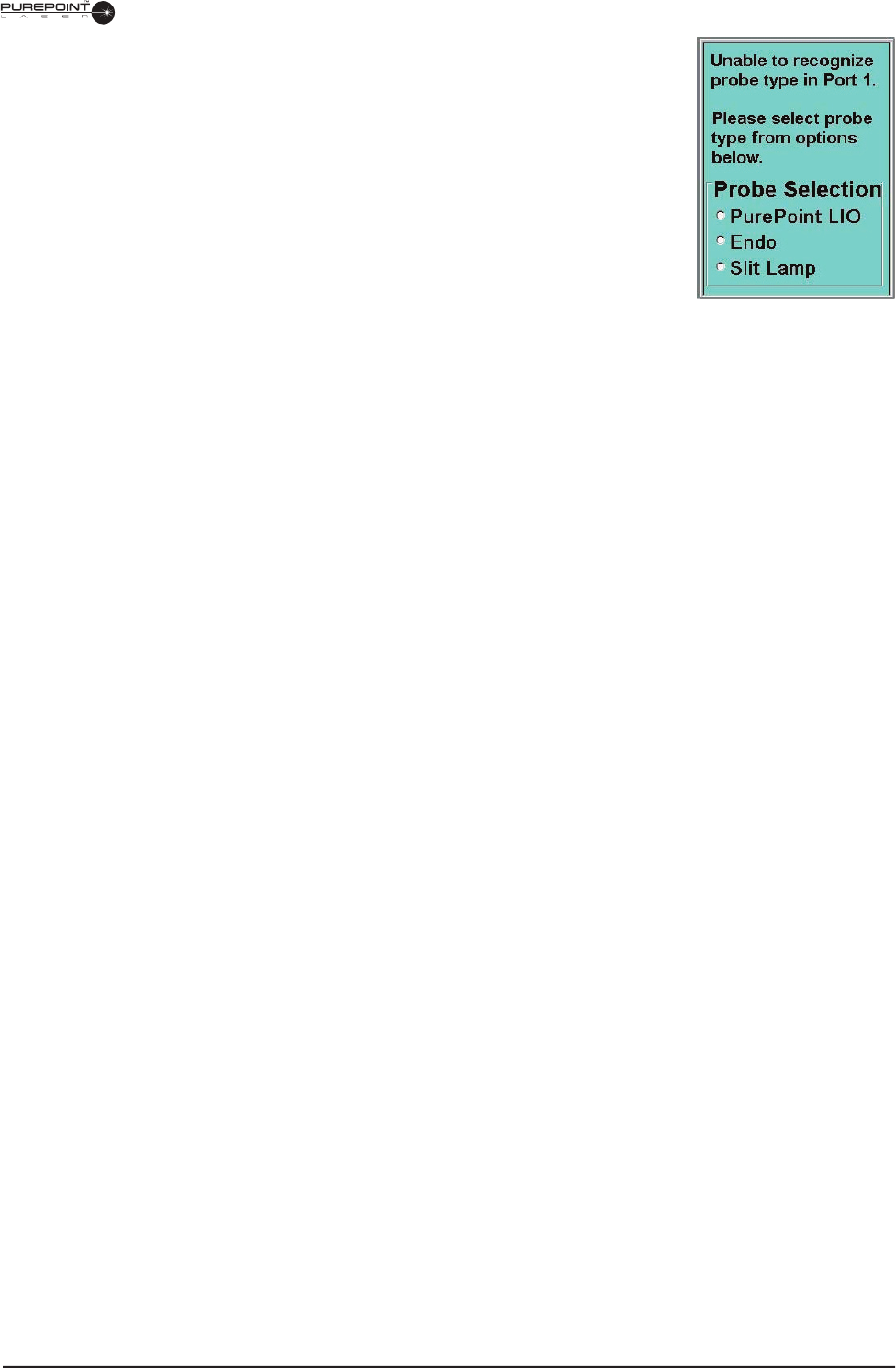
8065751131 2.3
A message is displayed as shown in Figure 2-3 prompting
the user to identify the probe as one of three instruments
displayed in the menu options.
After the user has identifi ed the probe:
• The Port Illumination Ring is illuminated in the color
green if the port is the only port with an identifi ed probe.
• The Port Illumination Ring is not lighted if the other port
already contains an identifi ed probe. The port with the
newly-identifi ed probe is not the selected port. The Port
Selection Button must be pushed for the probe to be
selected.
Disabled Port Indication Color:
RED
If the
PurePoint™
software determines a port cannot be
used due to a mechanical or software fault, the Port Illumination Ring is illuminated
in the color red.
Port Selection Buttons
When each port has an identifi ed probe, pressing one of the Port Selection Buttons
selects the associated port. The Port Selection Buttons are active only when there are
identifi ed probes in each port. In all other cases (such as an unidentifi ed probe in one
port, only one port being used, no identifi ed probes in a port, etc.) the
PurePoint™
software will take the correct action.
When a selection is made, the LED surrounding the desired port illuminates green. If
selecting a port for the fi rst time after starting the system with an identifi ed endoprobe
or slit lamp attachment, a screen is displayed asking the user to confi rm that the Dr.
Filter is in place.
Emergency Switch
Pressing the Emergency Switch turns off the laser system immediately. To restore
power, pull the Emergency Switch to the out position. The system will return to the
Standby mode.
Keyswitch
The Keyswitch is a two position switch where the key can be removed only in OFF
position. In the OFF position, the power to the laser is shut off. Switching to the ON
position turns the laser system on and the system will display the Standby screen.
Figure 2-3
Unidentifi able Probe
Selection Screen

2.4
8065751131
LIO Illumination Power Knob
The LIO Illumination Power knob adjusts the brightness of the LIO illumination
beam (if an LIO power cable is plugged into the LIO Power Port port, a LIO fi ber is
connected to a laser port, and the port is selected). Turning the knob right makes the
LIO illumination beam brighter and turning the knob left makes the beam dimmer.
When the LIO illumination beam reaches its maximum brightness, continuing to turn
the knob to the right has no effect. Similarly, when the LIO illumination beam reaches
its minimum brightness level, continuing to turn the knob to the left has no effect.
Aiming Beam Intensity Knob
The Aiming Beam Intensity knob adjusts the intensity of the the red laser aiming
beam. The system saves the intensity setting for each port. Therefore, when a laser
port is selected, the aiming beam intensity setting is the same as the last time the port
was selected. In addition, when the laser system has completed initialization, the
aiming beam intensity for the selected port is the same as the last time the system was
turned on.
Turning the Aiming Beam Intensity knob clockwise increases the intensity
towords the maximum (under 1 mW).
Turning the knob counter-clockwise decreases the power until it effectively turns
off.
Turning the knob further in either direction has no effect on the power of the
aiming beam.
LIO Illumination Power Port
The LIO illumination power cable connector is inserted into this port.
Menu Knob
The Menu knob allows the user to highlight and select a menu item shown on
the display. The knob rotates to move the highlighted fi eld on the display, and the
highlighted item is selected by pressing the knob.
Turning the Menu knob clockwise moves the highlighted fi eld to the right (or
down).
Turning the Menu knob counter-clockwise moves the highlighted fi eld to the left
(or up).
Continuing to turn the knob after highlighting the last menu item has no effect.
On menus in which several choices are required, turning the knob highlights the
space, but the knob must be pushed in to make a selection. A choice must be made
in each line or column.
For menu items containing values that can be modifi ed, turning the knob right
increases the value and turning the knob left decreases the value. Once the
maximum or minimum value for a setting has been reached, turning the knob in
that direction has no further effect.
•
•
•
•
•
•
•
•

8065751131 2.5
Standby/Ready Button
The Standby/Ready button switches the system between Standby and Ready modes.
The screen background changes color for each mode (gray for Standby, green for
Ready mode). In addition, each mode has an associated LED that illuminates when
that mode is active.
WARNING!
In Ready mode, pressing the footswitch will fire the laser.
To transition the system from Standby to Ready mode, press the Standby/Ready
button once. The transition proceeds as follows:
The LCD background color fl ashes between gray and green for the 2 seconds.
During those same 2 seconds, the Standby LED turns off, and the Ready LED
fl ashes on/off.
After the transition, the LCD background color remains green and the Ready LED
stays on indicating that the system is in Ready mode.
Various conditions prevent the system from transitioning to Ready mode including
the following:
Footswitch disconnected
No identifi ed probe connected
Remote interlock open
Tethered Dr. Filter disengaged
The LCD is displaying a menu screen
Pressing the Standby/Ready button while the system is in Ready mode, immediately
returns the system to Standby mode.
The Interval Time Knob
The Interval Time is the time between treatment shots when the treatment mode is set
for Repeat mode. The Interval Time knob can adjust the interval time to the following
values:
30 ms to 100ms in 10 ms steps
100 ms to 300 ms in 50 ms steps
300 ms up to 1 second duration in 100 ms steps.
The Interval Time Knob functions as follows:
Turning the knob clockwise increases the amount of time between pulses
(interval).
Turning the know counter-clockwise decreases the amount of time between
pulses.
Turning the knob counter-clockwise from the maximum interval time (1000 ms)
places the laser in Single Shot mode. Afterwards, turning the knob clockwise has
no effect.
Turning the knob clockwise from Single Shot mode will place the laser into
Repeat mode with the interval time set to 1000 ms.
Pressing the Interval Time knob sets the laser to Single Shot. Pressing the knob
again returns the system to Repeat mode using the previous Interval time. In CW
mode, turning or pressing the Interval Time knob has no effect.
NOTE: In Continuous Wave (CW) mode, the Interval Time knob is disabled
and interval parameter on the diplay is grayed out.
•
•
•
•
•
•
•
•
•
•
•
•
•
•
•
•

2.6
8065751131
The Pulse Duration Knob
The Pulse Duration Knob sets the duration (exposure time) of the laser emission and
it functions as described below:
Turning the knob clockwise increases the exposure time up to 2000 ms.
Turning the knob past the 2000 ms setting or pushing the knob places the system
in Continuous Wave (CW) mode. In CW mode, the Interval Time knob is
disabled.
Turning the Pulse Duration knob counter-clockwise from CW mode returns the
system to the previous mode: Single Shot or Repeat.
Turning the knob counter-clockwise decreases the exposure time. The lowest
available exposure time is 10 ms.
The Pulse Duration Knob adjusts the exposure time to the following values in
milliseconds:10, 20, 50, 100, 150, 200, 250, 300, 400, 500, 700, 1000, 1500, 2000
ms and Continuous Wave (CW).
NOTE: In CW (Continuous Wave) mode, depending on the thermal load of
the system, the system may shut down prior to the footswitch being
released, with an indication in the LCD display. It is not recommended
to use exposure times longer than 2 seconds in CW mode.
The Power Knob
The Power Knob is used to adjust the treatment laser power and it functions as
described below:
Turning the Power Knob clockwise increases the laser power.
Turning the Power Knob counter-clockwise decreases the power power.
The Power Knob adjusts the power setting to the values shown in Table 2-1.
Table 2-1 532 Green Laser Power Values (in milliwatts)
30 40 50 60 70 80 90 100 110 120 130 140
150 160 170 180 190 200 220 240 250 260 280 300
320 340 350 360 380 400 420 440 450 460 480 500
550 600 650 700 750 800 850 900 950 1000 1100 1200
1300 1400 1500 1600 1700 1800 1900 2000
NOTE: The
PurePoint™
laser determines the 532 green laser maximum
available power and limits the user setting to that maximum value if less than
2 W. The maximum selectable power may be less than 2 W (2000 mW) because
of the degradation of the laser engine over time.
•
•
•
•
•
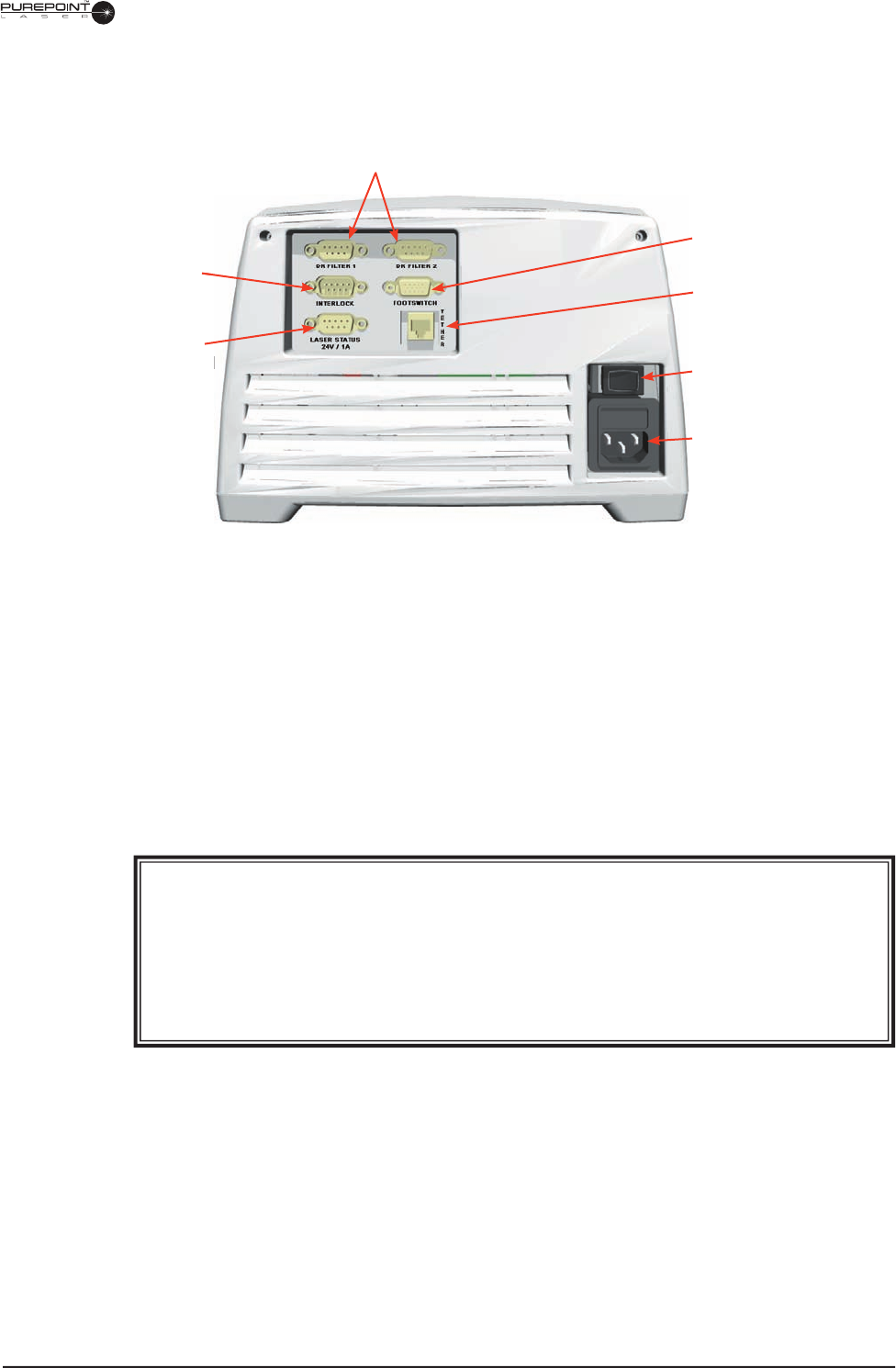
8065751131 2.7
REAR PANEL DESCRIPTION
Figure 2-4 The
PurePoint™
Laser Rear Panel
Doctor Protection Filter Ports
Two ports are provided to connect Doctor's fi lters. If more than one fi lter is needed,
both ports can be used at the same time. There is no direct correspondence between
the laser ports and Dr. Filter ports.
If the Doctor Protection Filter is not engaged, the warning message “Please Engage
Dr. Filter” is displayed on the LCD. This message is displayed every time a port
with a slit lamp or endoprobe fi ber connected is selected. Acknowledging the prompt
removes the warning message and allows normal operation to continue.
WARNINGS!
The operator may have a colored view through the Doctor Protection Filter due
to blocking of the 532 nm wavelength (green). Newer filters are more transparent
and provide a less-discolored view.
The operator must be careful to avoid potential secondary reflections. Therefore,
the treatment room should be approved by a qualified laser safety officer.
Footswitch Connection
Either a standard footswitch or a multi-function footswitch is connected to the system
through this port. The multi-function footswitch provides additional controls to
change laser power and switch between Standby and Ready modes.
Power Cord Connector and Main Power Switch
The power cable for the system is connected in this module and the power switch is
located above the power connection. If the Emergency Switch is pressed, the power to
the system is shut off even if the Main Power Switch is ON.
Dr. Filter Ports
Remote Interlock
Remote Interlock
Connector
Laser Status
Connector
Connector
Footswitch Connector
Tether Port
Main Power Switch
Power Cord Connector
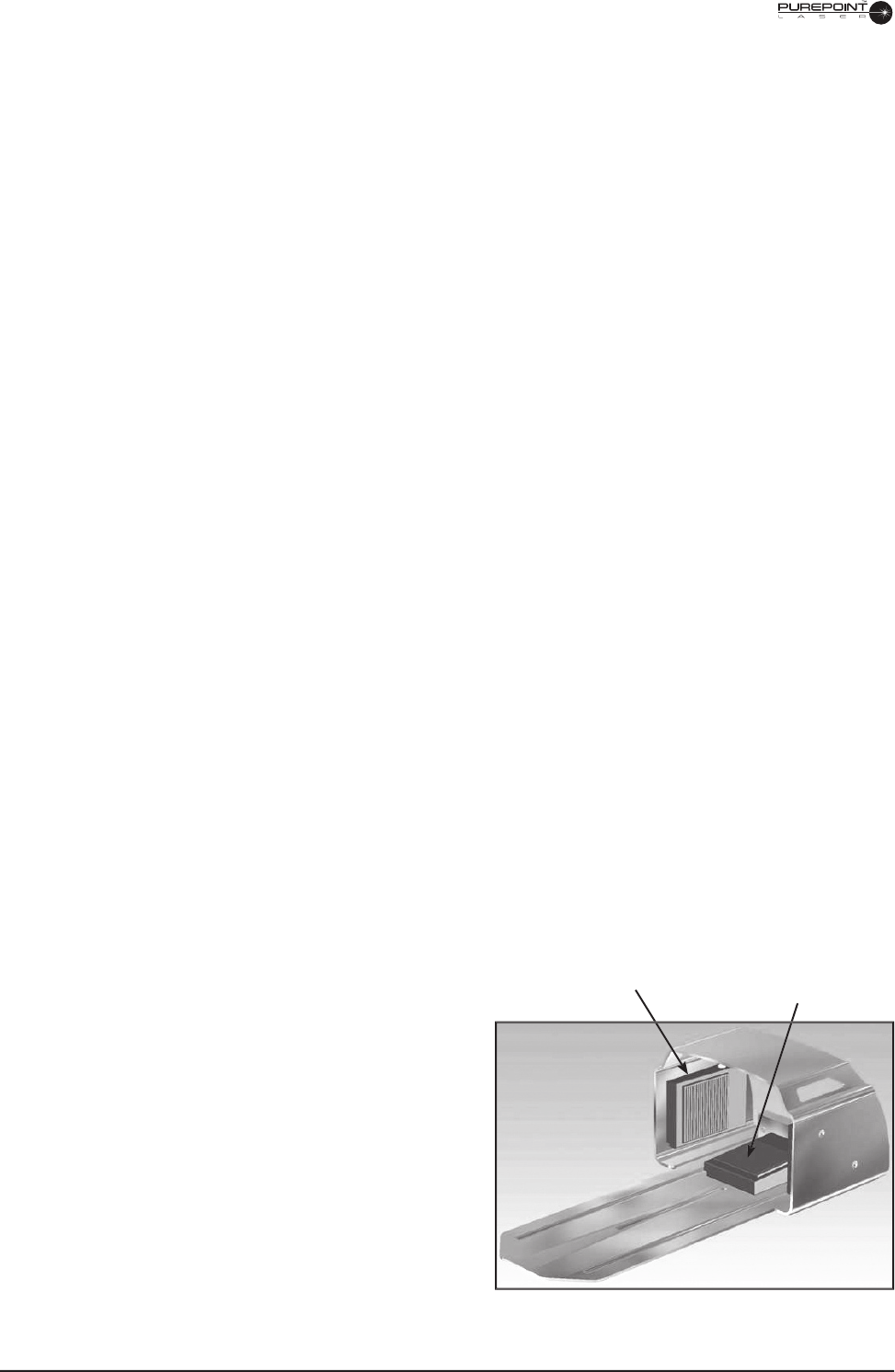
2.8
8065751131
Tether Port
This port is used by authorized service personnel to connect a service computer to the
system. A password is required to gain access to the system and this procedure can
only be performed by authorized service personnel.
Remote Interlock Port
The Remote Interlock Connection permits the facility to connect a door activated
switch and/or door warning lamp to the
PurePoint™
system (see Section One for
details).
When the Remote Interlock is activated and the connected door is opened:
when the system is in Standby mode, a message is displayed that prompts the user
to close the door prior to continuing.
when the system is in Ready mode, the system immediately goes to Standby
mode, and a message is displayed that prompts the user to close the door prior to
continuing.
when the system is in Firing mode, the laser is turned off, system goes to Standby
mode, and a message is displayed that prompts the user to close the door prior to
continuing.
Laser Status Connector
A lighted warning sign can be mounted at the entrance of the laser room and
connected to the system through this port. When connected, the system will turn the
warning sign on during Ready mode, and turn the sign off during Standby mode. The
port will drive a bulb with a max rating of 24 Vdc, 1A.
FOOTSWITCH
The multi-function footswitch shown in Figure 2-5 has a depressible pedal to fi re the
laser and side switches that can be confi gured via the Footswitch Settings screen to
perform other functions. The footswitch is lit by LED's to make it easy to fi nd in a
dark operating environment.
The side switches, located on the right and left side of the footswitch enclosure, are
either enabled or disabled according to the selection in the Footswitch Settings screen
(see the Footswitch Settings screen
description later in this section of the
manual). When enabled, they can be
confi gured to control laser power or
the transition between Standby and
Ready modes.
When changing the laser power,
holding a side switch depressed
does not auto-increment or auto-
decrement. The power value on the
LCD is updated when a side switch is
released. Therefore, each change of
value requires a separate press and
release.
•
•
•
Figure 2-5
PurePoint™
Multi-Function Footswitch
Side Switch (2) Footpedal

8065751131 2.9
SYSTEM MODES
The
PurePoint™
system has three modes describe the different operational states of
the system.
Standby Mode
The system starts in this mode after initialization. It also falls back to this mode in
response to various events. Settings can be adjusted in this mode, but the system
cannot deliver treatment laser energy.
Ready Mode
This mode is initiated when the Standby/Ready button is pushed while the system is
in Standby mode. After the button is pushed, the system pauses for 2 seconds, fl ashes
the parameters section of the LCD display, then the system transitions into Ready
mode. The system is now prepared to deliver treatment laser energy.
Firing Mode
Pressing the footswitch in Ready mode causes the system to deliver laser treatment
energy.
TREATMENT MODES
The system has three treatment modes that determine how the treatment laser shots
are delivered.
Repeat Mode
In this mode, pressing and holding down the footswitch pedal causes the laser to fi re
repeatedly, in a sequence. The individual shots have a duration set by the value in the
Pulse Duration fi eld of the display. The time interval between the shots is set by the
value in the Interval fi eld of the Display. Lifting the footswitch pedal stops the fi ring
sequence.
Single Shot Mode
In this mode, one treatment shot is delivered per each press of the footswitch pedal.
Continuing to hold down the footswitch pedal in this mode after the treatment shot
has been delivered shall have no effect. The Treatment Shot duration is set by the
value in the Pulse Duration fi eld of the display. Lifting the footswitch pedal stops the
fi ring sequence.
Continuous Mode
In this mode, pressing and holding down the footswitch pedal causes the laser to fi re
continuously as long as the footswitch pedal is depressed. Lifting the footswitch pedal
stops the fi ring sequence.
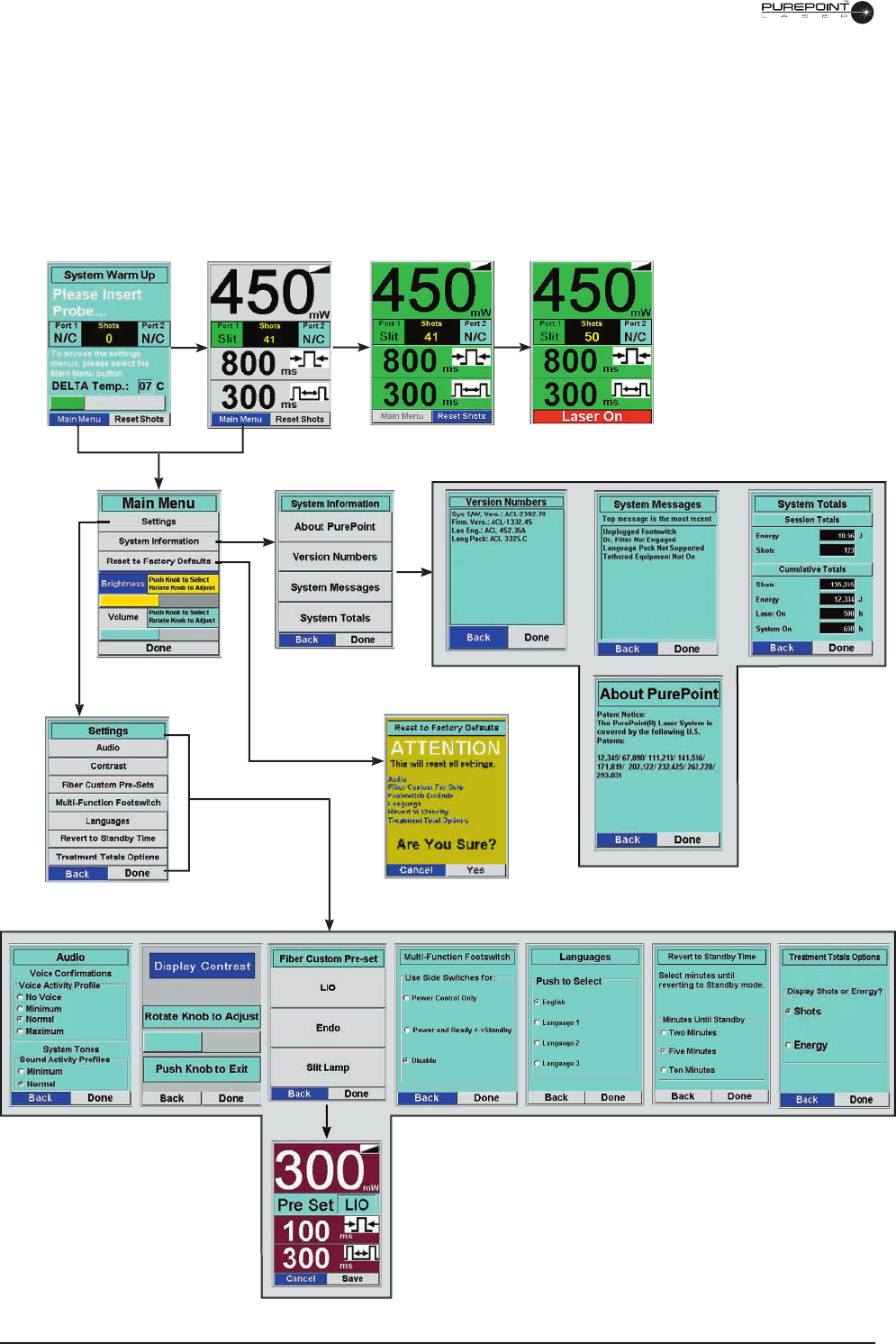
2.10
8065751131
Figure 2-6 Screens Displayed on the
PurePoint™
LCD
SCREEN DESCRIPTIONS
Figure 2-6 shows the hierarchy of screens displayed as you operate the system.
Navigation through the screens is accomplished by turning the Menu Knob to
highlight the desired selection, then pushing the knob in to activate the selection.
When available, pressing "Done" returns the system to the Standby screen, while
pressing "Back" takes the system back to the previous screen.
Initialization Screen Standby Screen Ready Screen Laser On Screen
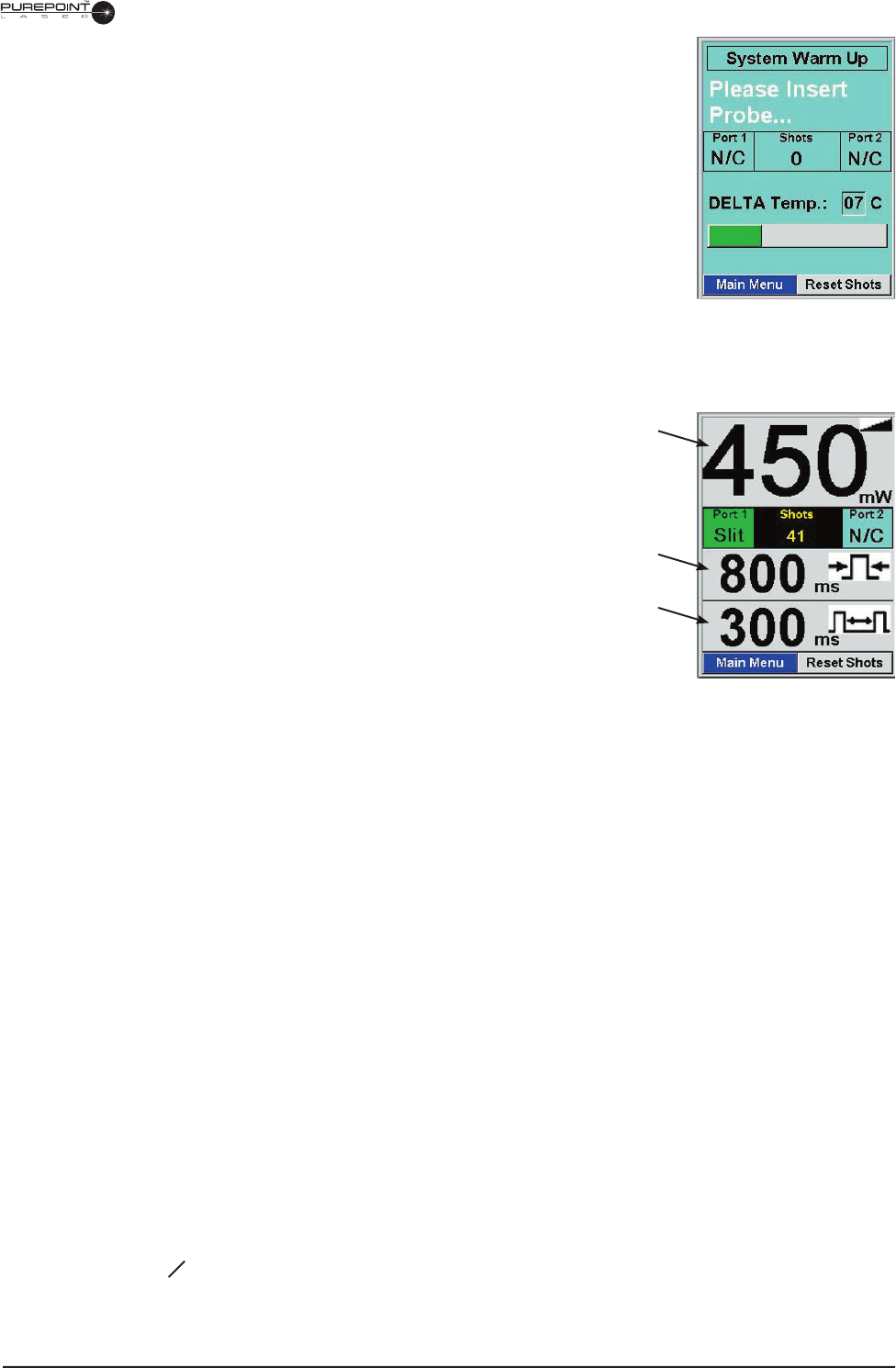
8065751131 2.11
INITIALIZATION SCREEN
The Initialization screen is displayed when the system is
powered on. The delta between the set point and actual
temperature of the laser engine is shown as it approaches
nominal operating temperature. The user can perform the
following setup operations during initialization: connect
probes, connect LIO illumination power, set laser parameters
if an identifi ed probe is connected, and view or change
system settings.
Figure 2-7
Initialization Screen
STANDBY SCREEN
The Standby screen is displayed after the
system has initialized and can be identifi ed
by its gray background as shown in Figure
2-8.
Laser Power
This fi eld shows the current setting for
laser power. The units are shown in
milliwatts (mW) for values from 30 to 980,
and in watts for values greater than 980.
Adjustments are made using the Power knob.
Pulse Duration
This fi eld shows the current setting for duration of the laser
emission. The units are shown in milliseconds (ms) for values from 10 to 700, and in
seconds for values greater than 700. Settings greater than 2 seconds causes the system
to enter Continuous Wave (CW) mode.
Interval Time
The Interval Time fi eld shows the time between treatment shots when Repeat mode is
selected. The units are shown in milliseconds (ms) for values from 30 to 900, and in
seconds for values greater than 900. Settings greater than 1 second causes the system
to enter Single Shot mode.
Port 1 and 2 Status Indicator
Port status is displayed in these fi elds with one of the following entries:
N/C - No fi ber connected
Endo- Endoprobe connected
Slit - Slit lamp fi ber connected
LIO - LIO fi ber attached
? - Fiber connected but not identifi ed
O
- Port is disabled
•
•
•
•
•
•
Laser Power
Pulse Duration
Interval Time
Figure 2-8
Operating Display-
Standby Screen
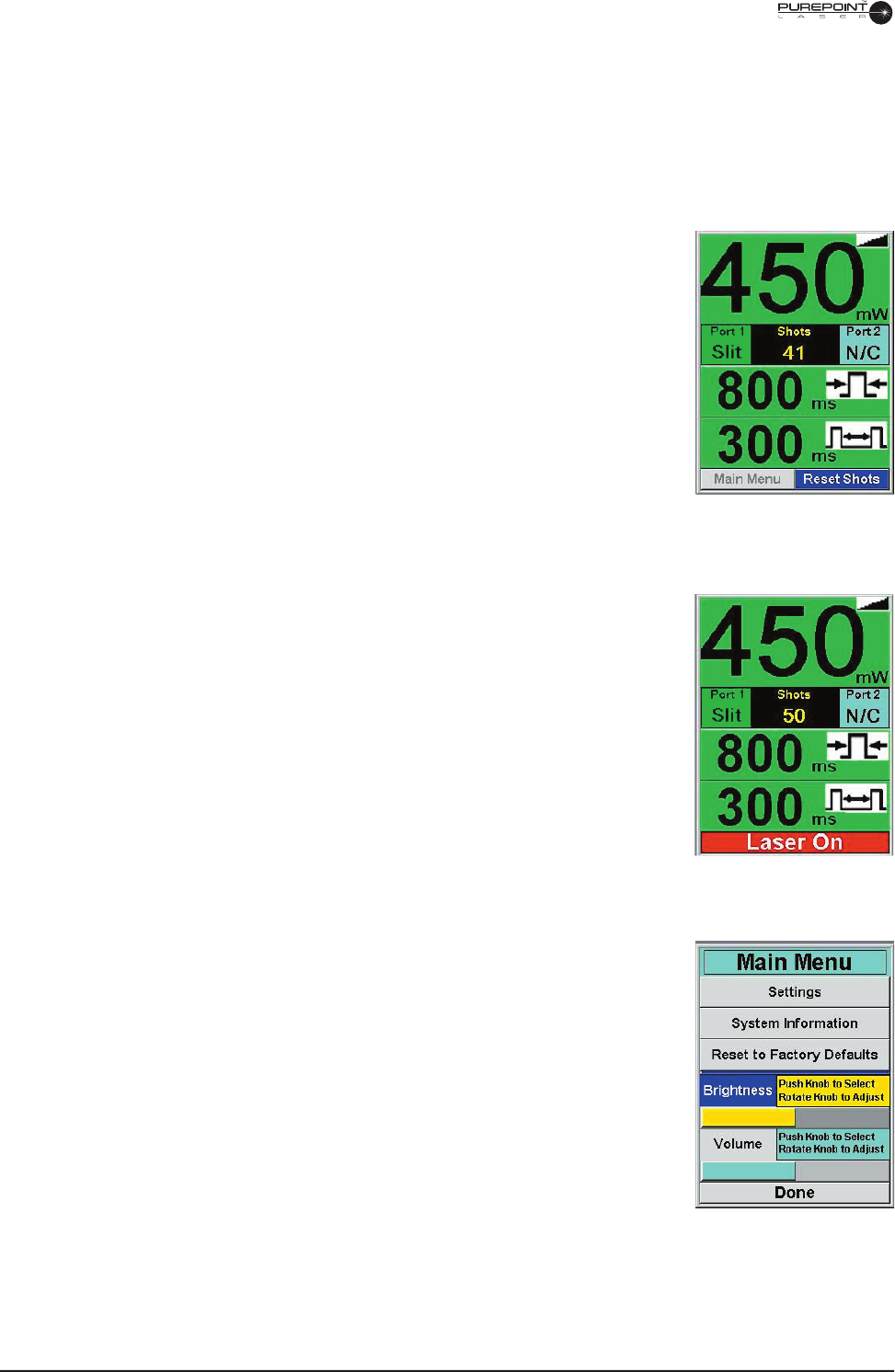
2.12
8065751131
MAIN MENU
The Main Menu is displayed by selecting "Main Menu"
from either the Initialization screen or the Standby screen.
The selection is made by rotating the Menu Knob until
"Main Menu" is highlighted, then pressing the knob to
activate the selection. The Main Menu, shown in Figure
2-11, allows the user to access screens that change system
settings and view system information. Each selection is
defi ned as follows:
Settings - System settings that can be adjusted by the
user.
System Information - Read-only system values provided
for the user's information.
Reset to Factory Defaults - Allows the user to quickly reset the system to its
default settings.
•
•
•
Shots/Energy
This fi eld displays the number of shots fi red since the unit was powered up or since
the user re-set the shot count. Through the Treatment Totals Options menu, the user
can set the system to display the energy (in Joules (J)) since the unit was powered up
or since the user re-set the value.
READY SCREEN
The Ready screen shown in Figure 2-9 indicates that the
system is ready to fi re. It is displayed when the user presses
the Standby/Ready mode button while the system is in
Standby. The screen is essentially the same as the Standby
screen except that the background is green and the Main
Menu button is inactive. Actions permited in this screen
include: adjusting the displayed parameters, resetting the shot
count, and connecting fi bers to the ports.
Figure 2-9
Ready Screen
LASER ON SCREEN
The Laser On screen shown in Figure 2-10 indicates that
footpedal has been depressed and the system is fi ring
the laser. In this screen the displayed parameters can be
adjusted. Releasing the footpedal sends the system back to
the Ready screen.
Figure 2-10
Laser On Screen
Figure 2-11
Main Menu
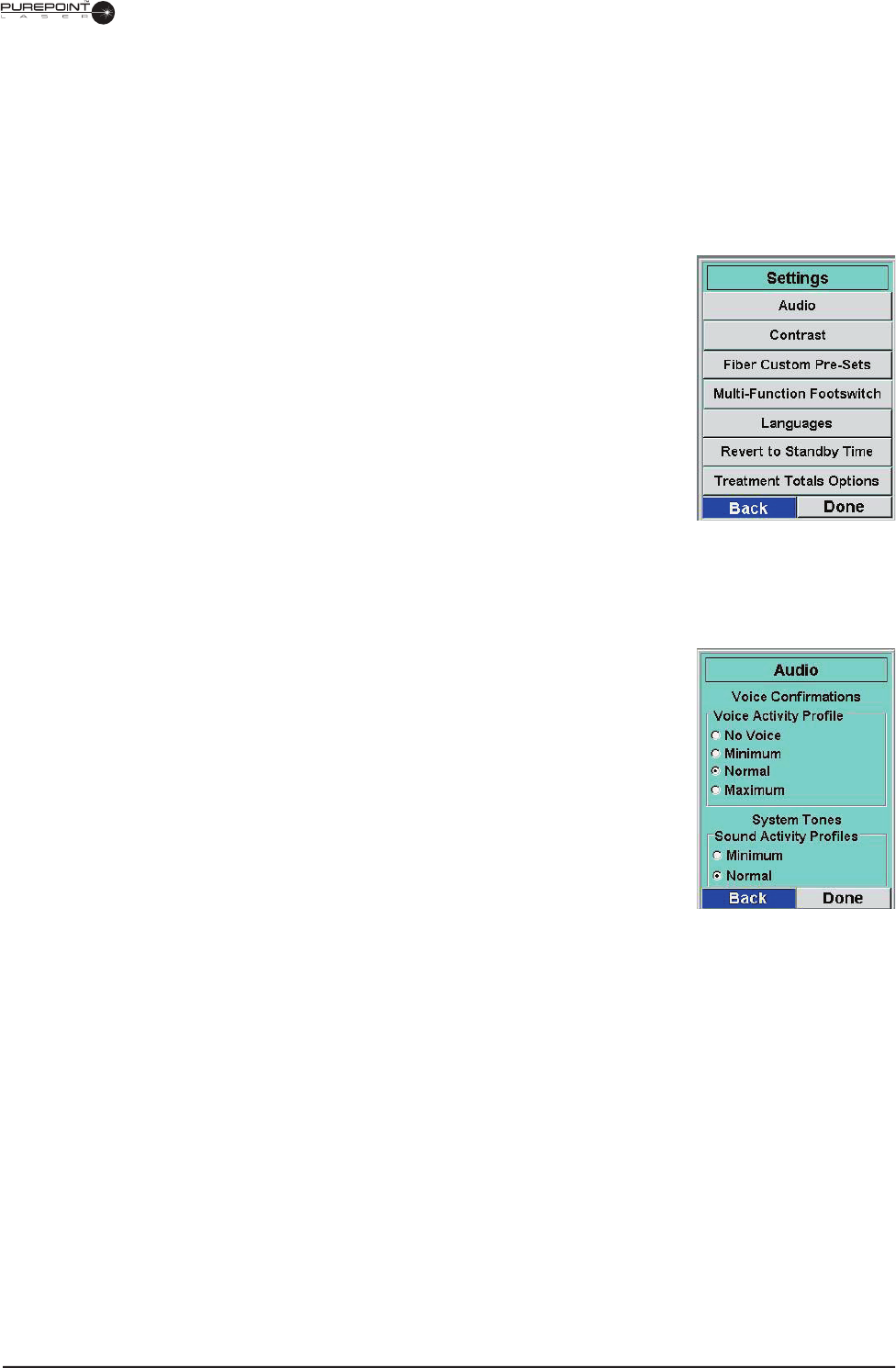
8065751131 2.13
Audio Settings
This menu allows the user to set the audio activity profi les for
Voice Confi rmations and System Tones. Figure 2-13 shows
the available selections for each profi le.
NOTE: Voice confi rmation is only available when Alcon
RFID probes are used.
Voice Confi rmations:
No Voice - Turns off all voice confi rmations completely.
Minimum - Allows the system to emit a minimum
number of voice confi rmation phrases.
Normal - Allows the system to emit a moderate number
of voice confi rmation phrases.
Maximum - Allows the system to emit all available voice confi rmation phrases.
System Tones:
Minimum - Allows the system to emit only the mandatory system tones.
Normal - Causes the system to emit all available system tones.
•
•
•
•
•
•
Brightness - This selection allows the user to control the brightness of the LCD
display and the front panel control illumination.
Volume - Controls the volume of system tones and voice confi rmation phrases.
NOTE: The volume of tones associated with errors and warnings is
adjustable through the Volume Level settings only to the levels specifi ed in
Federal regulations.
SETTINGS
Selecting "Settings" from the Main Menu displays the
system settings selections as shown in Figure 2-12. Each
setting may be changed according to the requirements of the
user.
•
•
Figure 2-12
Settings Menu
Figure 2-13
Audio Settings
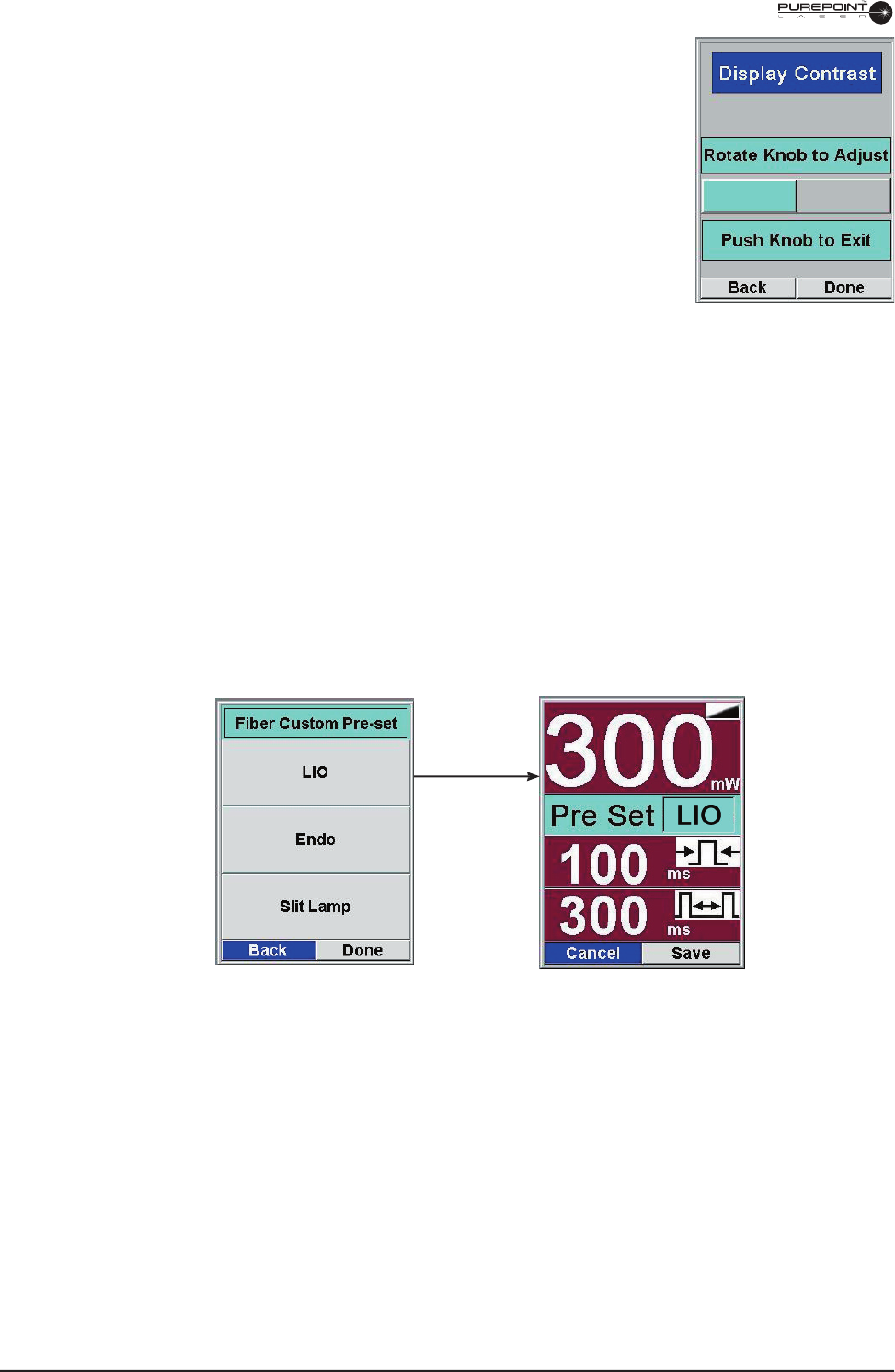
2.14
8065751131
Contrast
The Contrast menu allows the user to change the contrast
setting of the displays. When selected, the screen shown in
Figure 2-14 is displayed and rotating the Menu knob adjusts
the screen contrast. After the display has been adjusted to the
desired contrast, pressing the Menu button returns the display
back to the Settings screen.
Fiber Custom Settings
The Fiber Custom Settings menu allows the user to set and save the Power, Pulse
Duration, and Inter-Pulse Time parameters as pre-sets for the three instruments used
with the system. To select an instrument, rotate the Menu Knob until the desired
instrument is highlighted, then push the knob. The selected instrument's Pre-Set
screen appears as shown in Figure 2-15 where LIO was selected.
To pre-set an instrument parameter value, rotate the Power, Pulse Duration, and
Inter-Pulse Time Knobs to the desired values for the selected instrument. After the
settings have been changed, the user can select "Save" to save the changes and go to
the operating display or "Cancel" to revert back to the last saved pre-set.
Figure 2-14
Contrast Settings
Figure 2-15 Fiber Custom Pre-Sets Screen
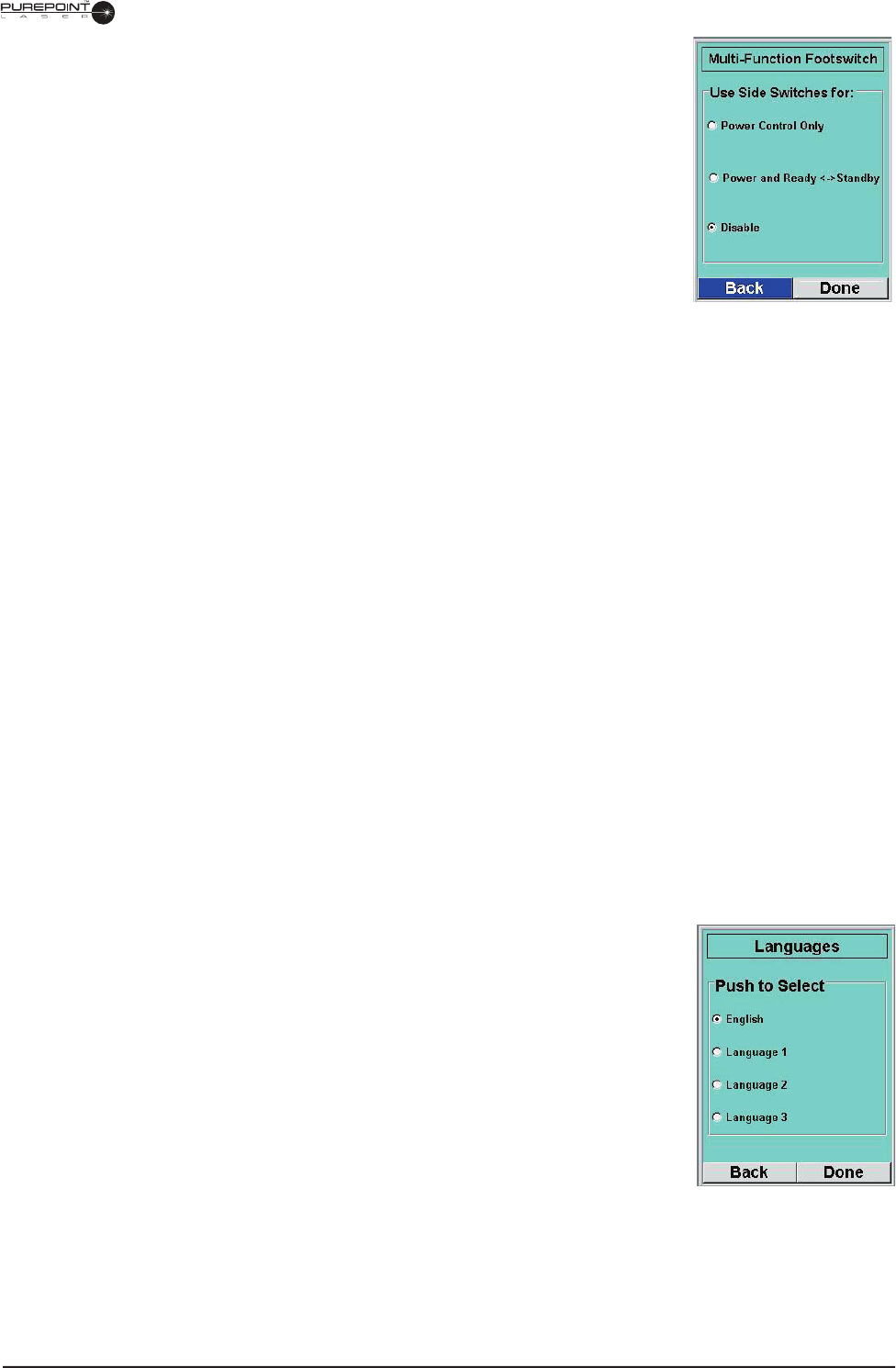
8065751131 2.15
Footswitch Settings
Selecting the Footswitch Settings menu item from the
Settings menu displays the Settings - Footswitch menu as
shown in Figure 2-16. This menu provides three settings
that allow the user to select the functionality of the side
switches.
NOTE: If the footswitch is not a multi-function
footswitch, the only functional setting is "Disable."
Power Control Only
This selection allows the side switches to increment (left
switch) or decrement (right switch) the treatment laser
power.
Power And Ready <-> Standby
When this selection is enabled, the user can transition from Standby to Ready by
pressing and holding the right side switch longer than 1.5 seconds until a tone sounds.
Similarly, pressing and holding the left side switch longer than 1.5 seconds (until a
tone sounds) will transition the system from Ready back to Standby.
Pressing the side switches for intervals shorter than 1.5 seconds will increase or
decrease treatment laser power.
Disable
This setting disables the side switches entirely so the footswitch can only be used
for fi ring the laser. When this setting is selected, power control and switching from
Standby to Ready mode can only be done from the front panel of the system.
Selecting Back returns the system to the Settings Menu, while selecting Done returns
the system to the operation display.
Languages
Selecting the Languages Setting displays the languages
available to the user for displaying the information on the
screen. To select a language, rotate the Menu knob until
the desired language is chosen, then press the Menu knob
to select the highlighted item. Select Back to return to the
Settings Menu or Done to return to the operating display.
The text displayed on the LCD will refl ect the new language
setting.
Figure 2-16
Footswitch Settings
Figure 2-17
Language Settings
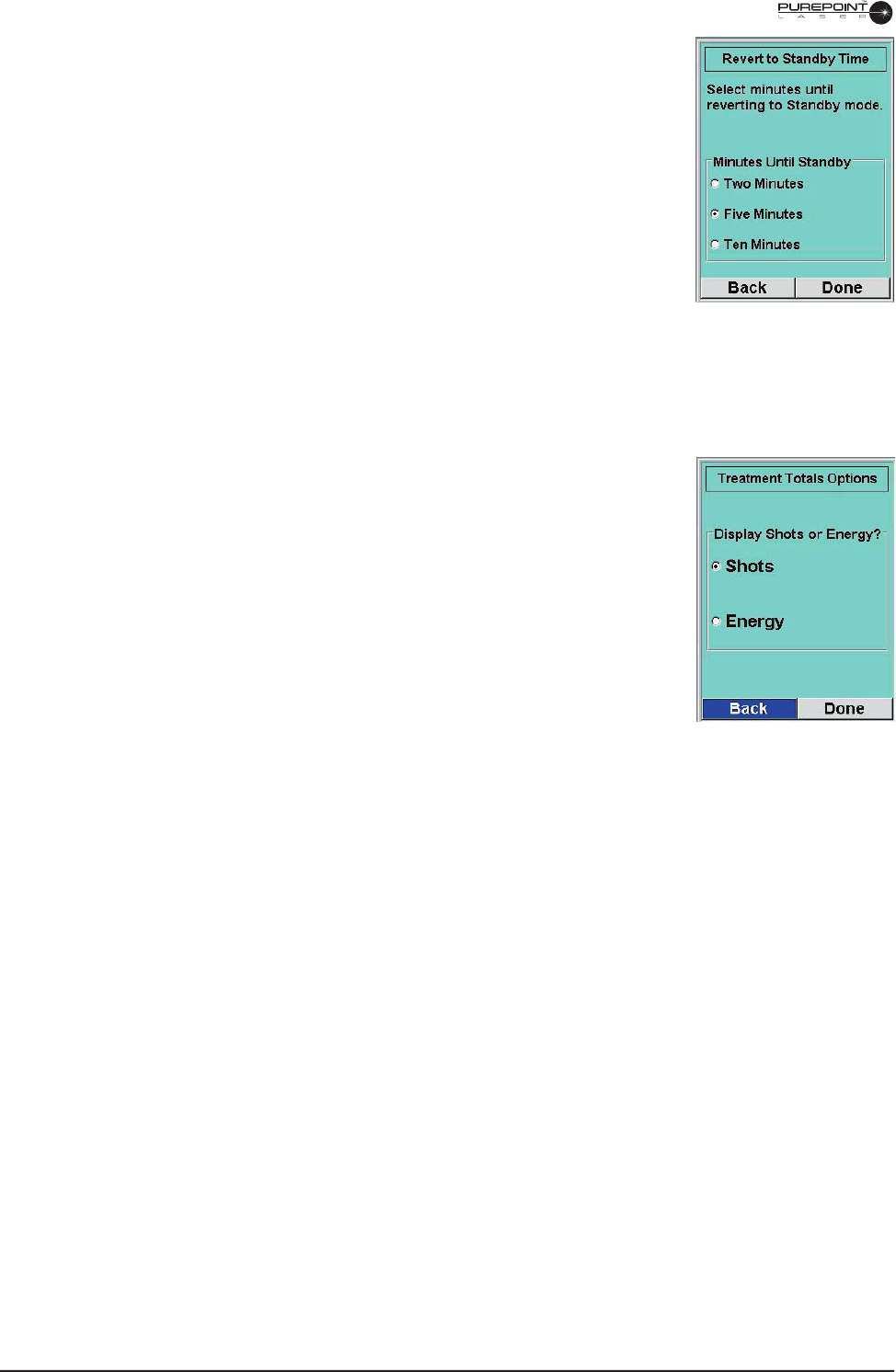
2.16
8065751131
Revert To Standby
Selecting the Revert to Standby Time menu item in the
Settings Menu displays the Revert to Standby menu as shown
in Figure 2-18. This setting determines the time period of
inactivity, in minutes, after which the system will revert to
the Standby mode of operation. Inactivity is defi ned as no
footswitch activation during the time period. The setting can
be adjusted to two, fi ve or ten minutes.
To change the setting, rotate the Menu knob until the desired
number of minutes is highlighted, then push the Menu knob
to select the value. Selecting Back returns the system to the
Settings Menu, while selecting Done returns the system to
the operation display.
Treatment Totals Options
Selecting the Treatment Totals Options menu item in the
Settings menu displays the Treatment Totals Display menu as
shown in Figure 2-19.
The selection in this menu determines whether the Shot
Count or the Total Energy Delivered value is displayed in the
status section of the operating display. These values pertain
to Treatment Totals only, as defi ned by either total shots or
treatment energy delivered from the time the System was
powered up, or since the user has re-set the count for this
fi eld, whichever is later.
To make a selection in the Treatment Totals Display menu,
rotate the Menu knob until the desired menu item is highlighted, then select the
setting by pushing the Menu knob. Selecting Back returns the system to the Settings
Menu, while selecting Done returns the system to the operation display.
Figure 2-18
Revert to Standby
Settings
Figure 2-19
Treatment Totals
Settings
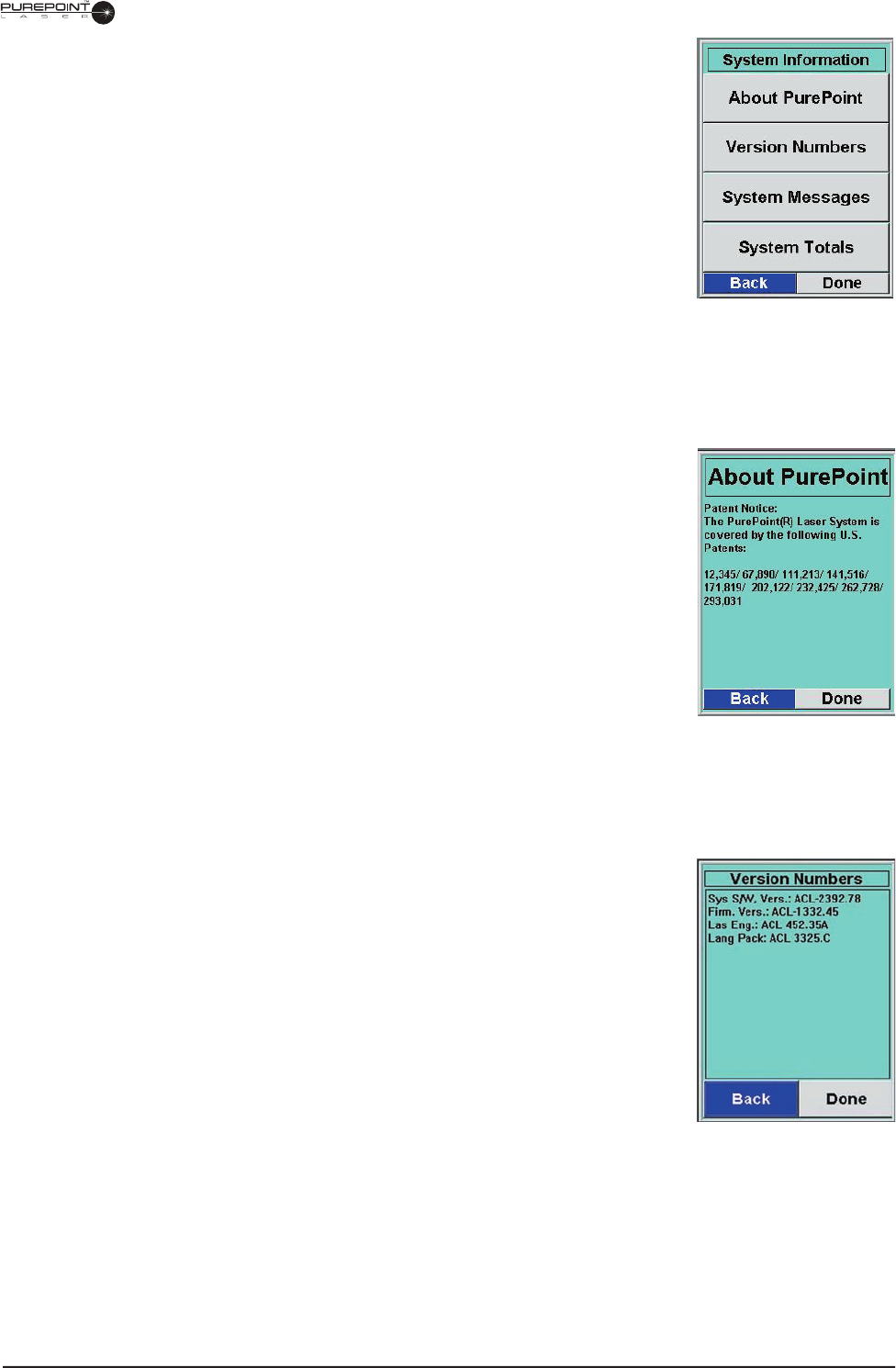
8065751131 2.17
SYSTEM INFORMATION
The System Information screen, shown Figure 2-20, is
displayed by selecting System Information from the Main
Menu. System Information includes read-only displays of
patents, various system constants, message histories, and
treatment totals.
About
PurePoint™
Selecting the About
PurePoint™
item in the System
Information menu displays information about the
PurePoint™
system such as the patent numbers that apply to
it as shown in Figure 2-21.
Version Numbers
Selecting Version Numbers from the System Information
menu displays the Version Numbers display as shown in
Figure 2-22.
The Version Numbers display is a list of system-related
version numbers that includes the currently installed
versions of system software, fi rmware, laser engine, and
language translation package. This is a read only screen
where the only available functions are the Back and Done
buttons at the bottom of the display.
Figure 2-20
System Information
Menu
Figure 2-22
Version Numbers
Information
Figure 2-21
About
Purepoint™
Screen
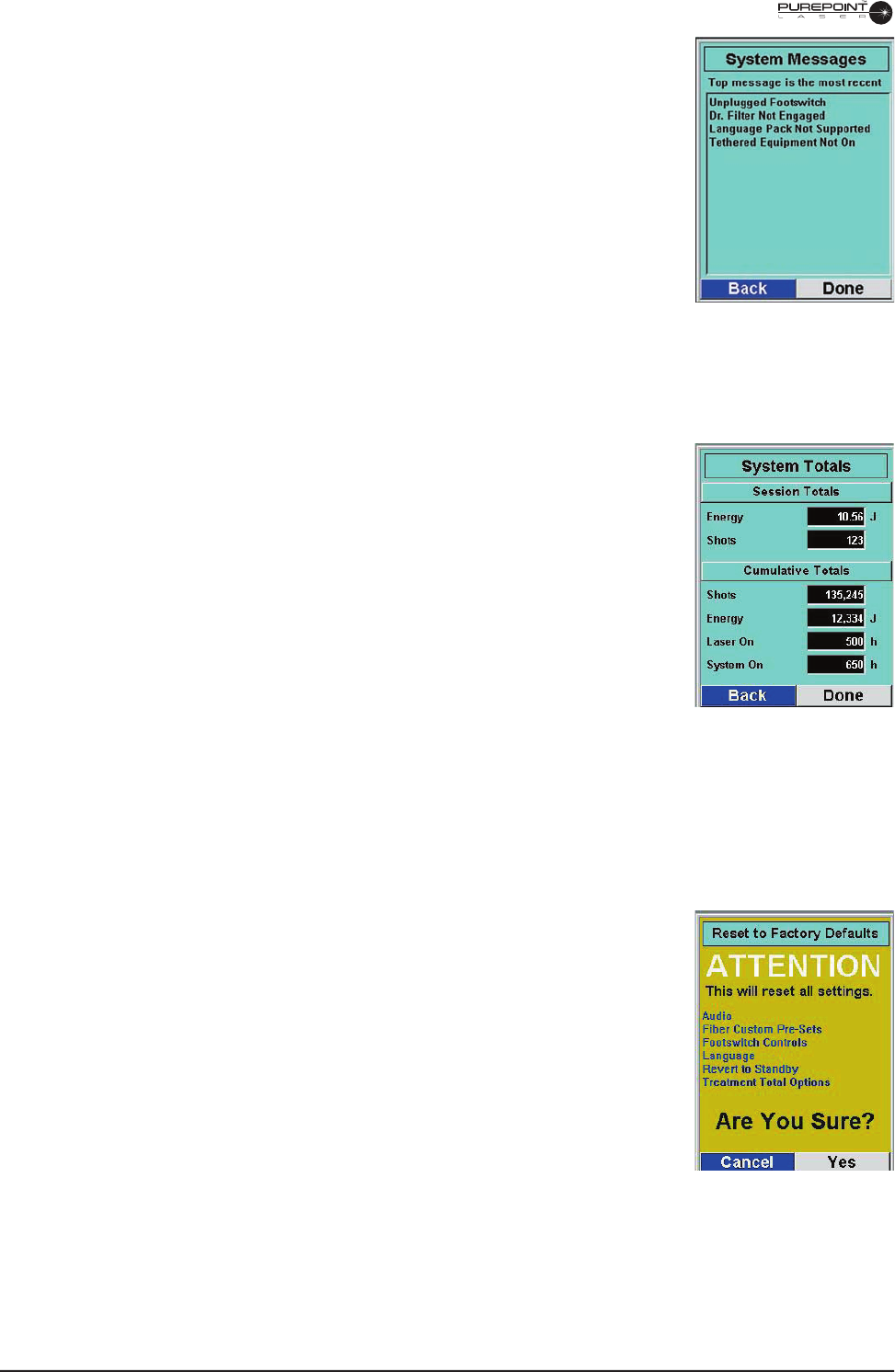
2.18
8065751131
System Messages
The System Messages display shown in Figure 2-23 contains
a scrolling list of system messages that have been logged
since the system delivered from the factory or was last
factory serviced and a new laser engine installed. System
Messages are defi ned as error, warning, or informational
messages that have been displayed to the user. The latest
message is displayed at the top of the list and the remaining
are listed in descending order.
System Totals
The System Totals display consists of two information items,
Session Totals and Cumulative Totals as shown in Figure
2-24.
Session Totals
Session Totals is the number of shots and the amount of Total
Energy delivered since the system was powered up.
Cumulative Totals
The Cumulative Totals displays the cumulative totals of
the listed treatment values. "Laser On" is the total time that
the laser engine has been powered up. This is equivalent to
the cumulative time the system has been in Ready mode.
"System On" is the total time the laser system has been powered up since it was
manufactured.
RESET TO FACTORY DEFAULTS
Selecting Reset to Factory Defaults from the Main Menu
displays the screen shown Figure 2-25. This screen allows
the user to re-set the system to the factory default settings.
Since this action changes many of the settings, the user
is prompted with an “Are you sure?” message before the
default settings take effect.
Selecting “Yes” will reset all factory settings to the original
settings and return the user to the Main Menu. “Cancel” will
cancel the operation and return to the Main Menu with the
settings unchanged.
Figure 2-23
System Messages
Figure 2-24
System Totals
Figure 2-25
Reset to Factory
Defaults Display

8065751131 2.19
BRIGHTNESS LEVEL
Selecting the Brightness menu item in the Main Menu allows the user to adjust the
brightness levels of the LCD display along with the front panel indicator lights.
When Brightness Level is selected, rotate the Menu knob until the desired brightness
level is achieved. The Indicator Bar provides a visual gauge for the brightness level.
When fi nished, push the Menu knob to save the Brightness Level changes.
VOLUME LEVEL:
Selecting Volume Level from the main menu allows the user to adjust the volume
of the system tones and voice confi rmations. The system provides a sample sound
or voice when a setting is changed. When Volume level is selected, rotate the Menu
knob until the desired volume level is achieved. The Indicator Bar provides a visual
gauge for the volume level. When fi nished, push the Menu knob to save the volume
level.
NOTES: The mandatory warning sounds cannot be adjusted above or below the
levels allowed by regulatory limits.
Voice confi rmation is only available when Alcon RFID probes are used.

2.20
8065751131
LAST PAGE OF THIS SECTION
8065751131
LAST PAGE OF THIS SECTION
8065751131
THIS PAGE INTENTIONALLY BLANK